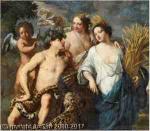Jan Miel
Jan Miel
Place: Beveren
Born: 1599
Death: 1663
Biography:
Jan Miel was a Flemish painter and engraver who was active in Italy. He initially formed part of the circle of Dutch and Flemish genre painters in Rome who are referred to as the 'Bamboccianti' and were known for their scenes depicting the lower classes in Rome. He later developed away from the Bamboccianti style and painted history subjects in a classicising style.
He collaborated with many artists in Rome and worked in the latter part of his career in Turin as the court painter of Charles Emanuel II, the Duke of Savoy.
Jan Miel was probably born in Beveren-Waas, but Antwerp and 's-Hertogenbosch have also been suggested as possible birthplaces. There is no information on his training but it is assumed that it took place in Antwerp. The seventeenth century Italian biographer Giovanni Battista Passeri refers to a training by Anthony van Dyck in Flanders but there is no independent evidence for this statement.
Miel's stay in Rome in the period from 1636 to 1658 is documented, but it is possible that he was already there from 1633. In Rome he became a member of the Bentvueghels, an association of mainly Dutch and Flemish artists working in Rome. It was customary for the Bentvueghels to adopt an appealing nickname, the so-called 'bent name'. For Miel two different bent names are documented: Bieco (which means squint in Italian) and Honingh-Bie (which means honey bee and is derived from the surname 'Miele' by which he was known in Italy and which means 'honey' in Italian).
In Rome he also became linked to the circle of genre painters whose work was influenced by the Dutch genre painter Pieter van Laer and were referred to as 'Bamboccianti'. The Bamboccianti were mainly Dutch and Flemish artists working in Rome who mostly produced small cabinet paintings or prints of the everyday life of the lower classes in Rome and the surrounding countryside. Jan Miel was a vital force in the development of this new tradition in Rome.
Miel became in 1648 the first northern artist to be admitted to the Accademia di San Luca, a prestigious association of leading artists in Rome. A stay of Miel in Northern Italy of around 1654 is documented. From 1658 until his death he resided in Turin, where he was appointed court painter of Charles Emanuel II, the Duke of Savoy.
Miel’s first dated paintings from the 1630s already show the influence of Pieter van Laer and the Bamboccianti in that they depict low-class subjects engaged in their normal business or at play. Popular subjects included morra players, gamblers, village dances, quacks, barbers, cobblers, itinerant musicians and actors, etc. Examples of his early work in this genre include The bowls players (Louvre) and The cobbler (Musée des Beaux-Arts et d'archéologie de Besançon), both produced in 1633. In this period he reworked and copied paintings by van Laer.
An example of a work in this so-called 'bambocciate' style is the Charlatan (Hermitage Museum, 1650s). The composition has traditionally been interpreted as depicting an itinerant medicine peddler with his assistants, who is demonstrating to a crowd of boorish onlookers the beneficial effects of his wares. The motif of quacks was a common feature of Flemish and Dutch genre painting from the 16th century onwards. In the 16th-century Jan Sanders van Hemessen's The Surgeon had depicted a quack surgeon pretending to remove with a knife from a patient's open skull the so-called 'stone of madness'. Seventeenth-century genre painting regularly returned to the theme as can be seen in the works of Adriaen Brouwer, Jan Steen and David Teniers the Younger. The main personages in the Hermitage painting are shown dressed as characters of the commedia dell'arte: the quack wears the mask and costume of Il Dottore while the guitar player has the costume of a Zanni (madcap servant). Jan Miel painted other works using characters from the commedia dell'arte such as Carnival in Rome (Prado Museum, 1653) and The Actors' Rehearsal (Zingone collection, Rome).
During the 1640s and 1650s Miel began, just like Michelangelo Cerquozzi, to expand the scope of bambocciate paintings by paying less attention to the surrounding landscape and instead stressing the anecdotal aspects of city and country life. These works were repeatedly used as a model by the Bamboccianti in the second half of the century and by the genre painters working in Rome during the early 18th century.
Miel made his most original contribution to genre painting through his paintings of carnival scenes. An example is the Carnival in the Piazza Colonna (Wadsworth Atheneum, 1645). The painting provides a powerful representation of the fury of carnival. As is common in Miel's 'bambocciate' compositions, noble and common people appear in the same scene: the Roman nobility mounted on horseback is dossed out in elegant costumes while the common people crowd the entire square engaging in merrymaking, panhandling, the game of morra and other lowly activities. A commedia dell'arte troupe standing on a cart also participates in the revelry. The merrymaking takes place on the last day of Carnival when the excitement has reached its peak. As Carnival also announces the beginning of spring, an effigy of winter is dangling from the gallows on the left.
More...
Wikipedia link: Click Here














